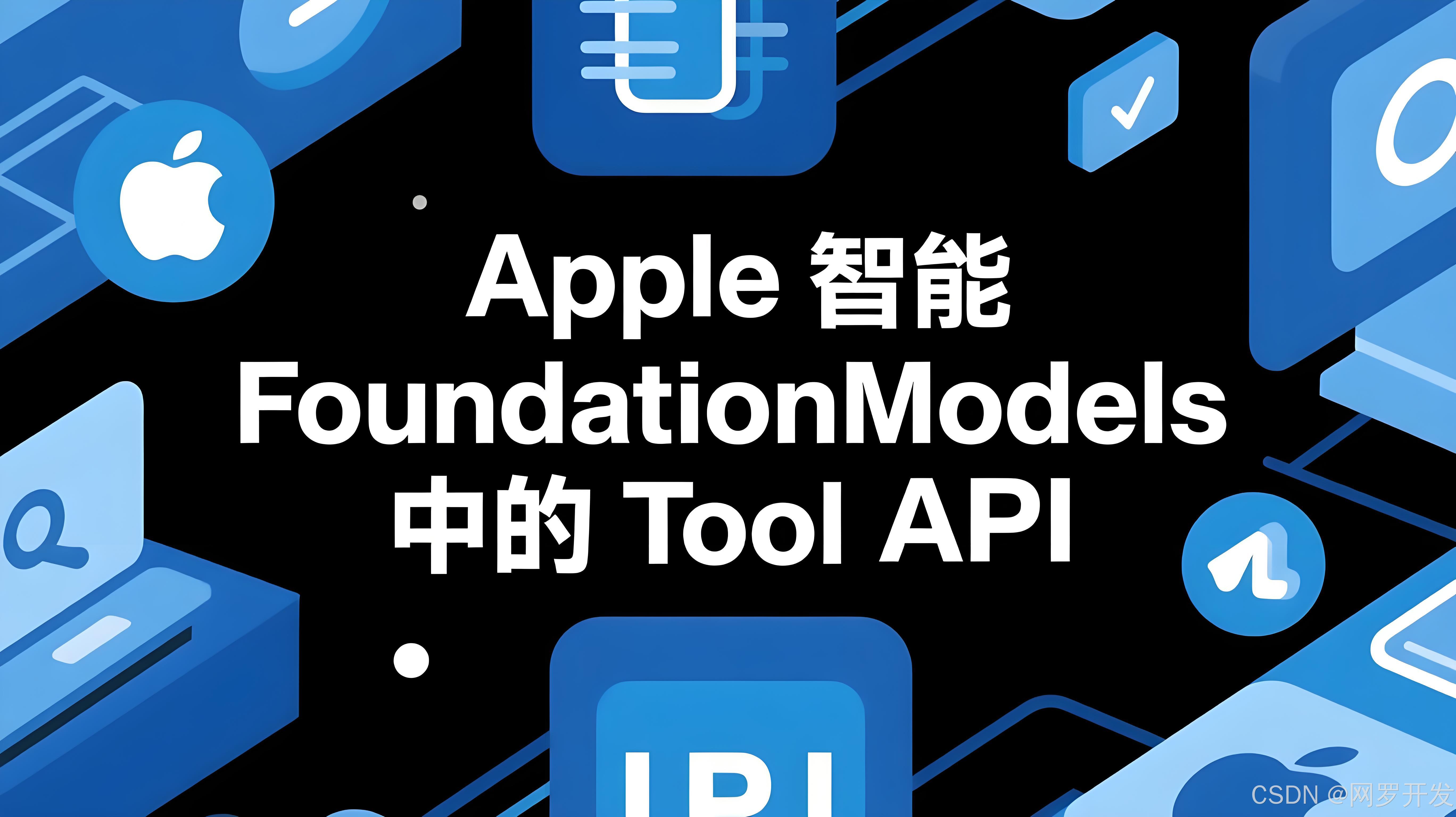
网罗开发 (小红书、快手、视频号同名)
大家好,我是 展菲,目前在上市企业从事人工智能项目研发管理工作,平时热衷于分享各种编程领域的软硬技能知识以及前沿技术,包括iOS、前端、Harmony OS、Java、Python等方向。在移动端开发、鸿蒙开发、物联网、嵌入式、云原生、开源等领域有深厚造诣。
图书作者:《ESP32-C3 物联网工程开发实战》
图书作者:《SwiftUI 入门,进阶与实战》
超级个体:COC上海社区主理人
特约讲师:大学讲师,谷歌亚马逊分享嘉宾
科技博主:华为HDE/HDG
我的博客内容涵盖广泛,主要分享技术教程、Bug解决方案、开发工具使用、前沿科技资讯、产品评测与使用体验 。我特别关注云服务产品评测、AI 产品对比、开发板性能测试以及技术报告,同时也会提供产品优缺点分析、横向对比,并分享技术沙龙与行业大会的参会体验。我的目标是为读者提供有深度、有实用价值的技术洞察与分析。
展菲:您的前沿技术领航员
👋 大家好,我是展菲!
📱 全网搜索"展菲",即可纵览我在各大平台的知识足迹。
📣 公众号"Swift社区",每周定时推送干货满满的技术长文,从新兴框架的剖析到运维实战的复盘,助您技术进阶之路畅通无阻。
💬 微信端添加好友"fzhanfei",与我直接交流,不管是项目瓶颈的求助,还是行业趋势的探讨,随时畅所欲言。
📅 最新动态:2025 年 3 月 17 日
快来加入技术社区,一起挖掘技术的无限潜能,携手迈向数字化新征程!
文章目录
-
- 前言
- 为什么"类型安全"这么重要?
- [通过 JSON Schema 保证结构完整性](#通过 JSON Schema 保证结构完整性)
- [错误恢复机制:让 AI 输出更稳](#错误恢复机制:让 AI 输出更稳)
- 结构一致性检测:防止"意外字段漂移"
- [类型安全 + 自动恢复 + 验证](#类型安全 + 自动恢复 + 验证)
- 实践总结
前言
在上一篇文章里,我们聊到了如何用 Foundation Model 生成结构化内容,比如让模型直接返回一个 Swift 的 Recipe 结构体。那只是个开始。
在真正的工程环境中,如果你想让模型生成的数据 安全、可靠、可验证,那就得进入更深的层次------类型安全生成(Type-Safe Generation)。
这一篇,我们就来讲讲在 Swift 中如何实现类型安全生成的三个核心要素:
- JSON Schema 映射与结构验证
- 错误恢复与兜底机制
- 结构一致性检测与类型约束
为什么"类型安全"这么重要?
AI 模型生成的内容,往往是非确定性的。
比如你让它输出一个 Recipe,结果它有时候忘了某个字段、有时候输出字符串而不是数字,甚至干脆来一句:"抱歉我不知道热量是多少。"
这在 Demo 阶段没问题,但放进真实 App 时,会出现:
- JSON 解析失败;
- 数值字段返回字符串;
- 结构字段缺失导致 UI 崩溃。
所以我们需要在模型层与 Swift 类型系统之间建立一道"安全防火墙"------让 AI 的输出必须符合结构规范,否则自动恢复或报错。
通过 JSON Schema 保证结构完整性
Swift 的 @Generable 宏虽然能指导 Foundation Model 生成结构化数据,但我们还可以在生成前动态构建 Schema,明确告诉模型哪些字段必须存在、类型是什么。
实践思路
我们可以通过定义一个简单的 Schema 描述器来辅助模型生成:
swift
struct SchemaField {
let name: String
let type: String
let required: Bool
}
struct Schema {
let name: String
let fields: [SchemaField]
func asPromptDescription() -> String {
var description = "The output must strictly follow this schema:\n"
for field in fields {
description += "- \(field.name): \(field.type)\(field.required ? " (required)" : "")\n"
}
return description
}
}然后在生成时拼进指令:
swift
struct Intelligence {
private let recipeSchema = Schema(
name: "Recipe",
fields: [
.init(name: "title", type: "String", required: true),
.init(name: "energy", type: "Double", required: true),
.init(name: "ingredients", type: "String", required: false),
.init(name: "steps", type: "String", required: false)
]
)
func generateRecipe(with ingredients: String) async throws -> Recipe {
let schemaPrompt = recipeSchema.asPromptDescription()
let instructions = """
You are a nutrition expert. Generate a recipe using the given ingredients.
\(schemaPrompt)
"""
let session = LanguageModelSession(instructions: instructions)
let recipe = try await session.respond(to: ingredients, generating: Recipe.self)
return recipe.content
}
}优势
这种做法的好处是:
- 模型会被强制遵循结构;
- 输出结果更稳定;
- 对未来扩展(比如 API 响应结构)更安全。
错误恢复机制:让 AI 输出更稳
模型生成失败时最常见的两类问题:
- 格式错误:JSON 括号缺失、字段顺序错误;
- 语义错误:字段类型不对,或数值溢出。
一种实用做法:多阶段生成
我们可以把生成过程拆成两步:
- 让模型生成原始 JSON 文本;
- 再用 Swift 层进行 JSON 验证和恢复。
swift
struct RecoveryManager {
static func decode<T: Decodable>(_ json: String, as type: T.Type) throws -> T {
do {
return try JSONDecoder().decode(T.self, from: Data(json.utf8))
} catch {
print("JSON Decode failed, trying auto-fix...")
let fixed = json.replacingOccurrences(of: "\n", with: "")
.replacingOccurrences(of: "```json", with: "")
.replacingOccurrences(of: "```", with: "")
return try JSONDecoder().decode(T.self, from: Data(fixed.utf8))
}
}
}结合生成逻辑使用:
swift
let raw = try await session.respond(to: prompt)
let recipe = try RecoveryManager.decode(raw.content, as: Recipe.self)这种"带自动修复"的解析方式能让模型输出在多数情况下自愈,极大提高稳定性。
结构一致性检测:防止"意外字段漂移"
在实际项目里,我们经常会调整数据结构。比如把 fatTotal 改成 fat,或者新增 dietType 字段。
模型生成的结构也要同步更新,否则会出现"旧字段还在被填充"的问题。
可以增加一个轻量级一致性检测模块:
swift
extension Decodable {
static func validateKeys(in json: String) -> [String] {
guard let data = json.data(using: .utf8),
let dict = try? JSONSerialization.jsonObject(with: data) as? [String: Any] else {
return []
}
return dict.keys.sorted()
}
}
let json = """
{
"title": "Grilled Chicken",
"energy": 450,
"fatTotal": 20
}
"""
let keys = Recipe.validateKeys(in: json)
print("Detected keys:", keys)可以配合 Schema 校验,确保生成结果和定义一致,否则提醒开发者模型未更新。
类型安全 + 自动恢复 + 验证
完整 Demo:
swift
import FoundationModels
@Generable
struct Recipe: Codable {
@Guide(description: "Title of the recipe.")
let title: String
@Guide(description: "Total energy in kcal.")
let energy: Double
@Guide(description: "Ingredients separated by commas.")
let ingredients: String?
@Guide(description: "Steps separated by newlines.")
let steps: String?
}
struct SafeIntelligence {
private let recipePrompt = """
You are a professional nutritionist.
Generate a healthy recipe. The output must be valid JSON matching the Recipe struct.
"""
func generateRecipe(with ingredients: String) async throws -> Recipe {
let session = LanguageModelSession(instructions: recipePrompt)
let raw = try await session.respond(to: ingredients)
let recipe = try RecoveryManager.decode(raw.content, as: Recipe.self)
return recipe
}
}
@main
struct DemoApp {
static func main() async {
do {
let ai = SafeIntelligence()
let recipe = try await ai.generateRecipe(with: "salmon, olive oil, lemon, garlic")
print("Recipe generated:", recipe)
} catch {
print("Generation failed:", error)
}
}
}运行输出可能是:
txt
Recipe generated: Recipe(title: "Lemon Garlic Salmon", energy: 380.0, ingredients: "salmon, olive oil, lemon, garlic", steps: "1. Marinate salmon...\n2. Grill and serve.")实践总结
结构化内容生成在 Swift 中变得更安全可靠后,你可以将它放心用于生产系统,比如:
| 应用场景 | 类型 | 示例 |
|---|---|---|
| 健康食谱推荐 | Recipe |
生成带营养信息的菜谱 |
| 智能学习助手 | LessonPlan |
输出课程结构与难度 |
| 商品描述生成 | ProductCard |
统一字段结构自动上架 |
| 聊天角色定义 | PersonaProfile |
控制语气、知识范围 |
| 报告摘要生成 | ReportSummary |
提取关键信息自动填充表格 |
在实际工程中,类型安全生成让你从"内容混乱的字符串世界"进入了"有结构、有约束、可验证"的新时代。